#paul poiret gown
Explore tagged Tumblr posts
Text
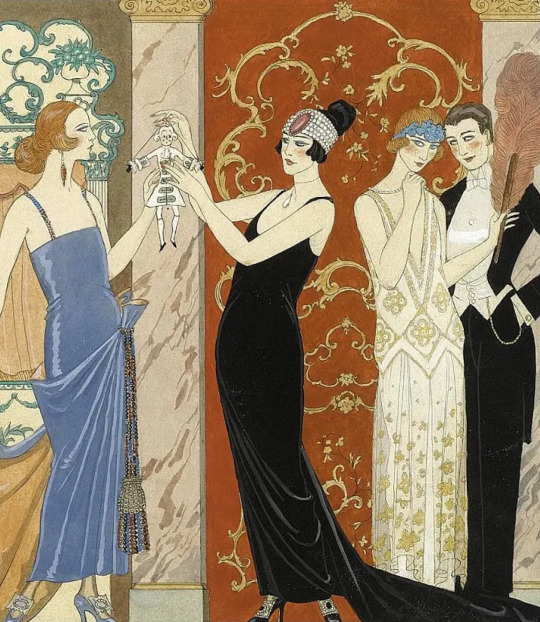
George Barbier, Puppets, La Comédie de Salon, Haute Couture by Georges Doeuillet, Worth (Jean-Philippe Worth), Lucien Lelong, Madeleine & Madeleine, Molyneux (Edward Molyneux) and Paul Poiret, detail, 1922.
#george barbier#illustration#1922#puppets#fashion illustration#detail#art deco#art#painting#chic#couture#elegant parisienne#party gowns#1920s gowns#20s gowns#jazz age#20s paris#paris fashion#evening gowns#paul poiret#georges doeuillet#worth#maison worth#lucien lelong#madeline & madeline#molyneux#haute couture#gowns#Edward Molyneux#Jean-Philippe Worth
145 notes
·
View notes
Photo
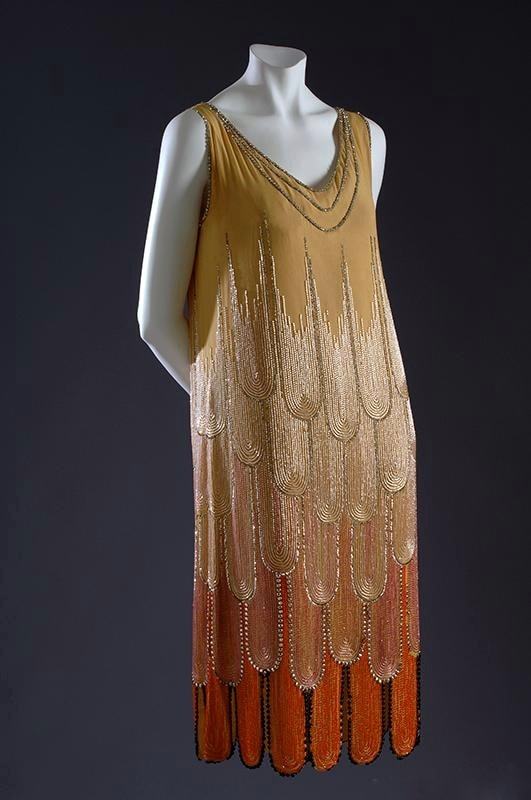

1926 c. Paul Poiret evening gown of gold silk chiffon, rhinestones and beads. The beadwork resembles the “fountain” motif, but turned upside down, evoking trompe l’oeil fringe. From Fashion of Bygone Days, FB
2K notes
·
View notes
Text
As the first official post of the new side blog I thought I’d share with yall the process of how I went about re- designing/writing/imagining the characters and story of Lily Orchard’s PokéMadhouse!
Re-Madhouse — G
Starting with the as Lily puts “Co-Protagonist” of PokéMadhouse, G the gardevoir.

When I first read madhouse I didn’t like the way G was written, I couldn’t accept that she was truly the one who did wrong granted the circumstances of the real life relationships that get this toxic, for the life of me I felt that G was the victim. From the way she’s written to her internal (and lack of struggle that isn’t resolved with a “get over it” by Lily) struggles/conflict. The way G comes off when interacting with other Pokémon, people and even Lily she acts like an abused dog who is on edge every millisecond of their life afraid of being hurt and dying.


G was always detached and acting like someone stronger than she was always masking and hiding. She was scared and confused and irrational. While reading I just couldn’t shake the feeling that Lily was lying to G about the bond shit and that’s what got me motivated and inspired to write G the way I did:
A nervous and anxious Pokémon who has to keep her head on a constant swivel to make sure she doesn’t get caught off guard by Lily or the other Pokémon on Lily’s ‘main team’ while wandering the halls in a confused and lucid daze.
So I took this to mind and heart when I was redesigning her. Of course this was after I did a semi satiric piece that applied my personal headcannon and take on the ralts line with given scientific applications to it! {click here for that!}

But when it came to actual elements for G in “Bonnie’s Day Out!!” I started to do my research and gathering for reference that would not only fit well with her silhouette but her character as well!

The basis of her design was heavily based on Anthy from RGU. Getting proper information from @saiscribbles as to her character thriughout the show: plots, goals, arcs and motivation; but more importantly her relations with the characters around her.
When it came to the style I had already locked in on limitations and rules for my version of gardevoir:
Depending on the age/maturity of the kirlia when they evolve (exp ≠ age) the style of “gown” will match and stay even as they age.
Younger gardevoir have more fairytale/disney princess type gowns
Older gardevoir have sharp, mature and a runway flare to the gowns
That being said; I immediately began to look up designers who screamed for my attention that suited G! But I wanted to find designers who had a somewhat hard life or story to really feel appropriate. The two I found the most right with G were: Paul Poiret and Cristóbal Balenciaga.


With all my ingredients ready I went into designing the final look!

It means the world to know y’all are loving this series and rest assured to know that there will be more posts like this where I share my process of reimagining PokéMadhouse!
#Re-madhouse#reimagining Lily’s pokemadhouse#bonnie’s day out#lily orchard critical#lily orchard is a bad writer#PokéMadhouse G#G pokemadhouse#sillygoblinantics#gobbo’s story and concept tidbits
29 notes
·
View notes
Text
Life at Bolougne-sur-Seine - Part 2

While escaping the rigors of the protocol, their lives nevertheless obeyed strict rules. The family gathered every morning in the small dining room exclusively reserved for their use because when the countess entertained, the table was set in another room - with chairs hung with pale yellow silk. The sun streamed in through the large windows and fell on the precious Chinese vases above the fireplace. While chatting, the children and their mother enjoyed coffee with milk and brioches, while Grand Duke Paul preferred tea, which he drank from a large glass held by a gold glass-holder on which his initials were engraved. The morning continued with home lessons for the children and walks. The Countess of Hohenfelsen, for her part, did her fittings with the couturiers, the most famous of whom were Poiret, Worth, Paquin and the Callot sisters. The numerous photographs that survive from the years between 1902 and 1914 show us an extremely elegant woman, wearing large “Merry Widow” hats, inspired by Franz Lehar's masterpiece, and dressed in “gowns of promenade or evening dresses that were probably made in ivory satin, Lanvin blue crepe de chine or pale pink, pearly gray or light biscuit lace. (...) At half past twelve - Grand Duke Paul was extremely punctual - the family met again for lunch, which was very rare at the time, as the children generally took their meals separately from their parents. (...) At the end of the afternoon, the children left the nursery - on the second floor - and their teacher to share a light snack with their parents. Every day, a pastry chef made sandwiches and soft breads, ordered in the morning for five o'clock tea. A short walk in the garden, a visit from friends, and dinner time arrived. It was the only meal Irene and Natalie ate alone. The two sisters returned very early to their rooms, on the top floor, and always took care to close, behind them, the large staircase with a gate which slid along the banister so that the little girls, if they happened to wake up in the middle of the night, could not, under any circumstances venture alone on the polished and slippery steps. When they were not held back by their many worldly obligations, the Grand Duke and his wife spent the evening calmly in the small library. Paul read aloud and Olga, dressed in a tea-gown at his request, embroidered. Then he retired to his study to update his journal, a diary made in Russia with varnished wood binding and gilded metal clasp. The memory of the clan in exile.
Natalie Paley: Princesse en Exil - Jean-Noel Liaut
#romanov#paul alexandrovich#imperial russia#royalty#grand duke#olga paley#morganatic marriages#belle époque#early 20th century#natalie paley#irina paley#vladimir paley
12 notes
·
View notes
Text

Camilla Belle | Jean Paul Gaultier Spring 2007 Couture gown | Met Gala: Poiret: King of Fashion | 2007
#camilla belle#jean paul gaultier#jean paul gaultier spring 2007 couture#met gala#2007 met gala#2007#blue
7 notes
·
View notes
Text
Fashion Showdown: Green (Match 13)


24 notes
·
View notes
Text
More images of 1912 fashion -
1912-1913 Afternoon dress.
1912 (Winter) Jeanne Paquin evening gown (Helen Larson Historic Fashion Collection, FIDM Museum - Los Angeles, California, USA).
1912 (Winter) Jeanne Paquin evening gown (Helen Larson Historic Fashion Collection, FIDM Museum - Los Angeles, California, USA).
Left 1912 Lucile dress (V&A). From omgthatdress.tumblr.com/post/654088327176306688/evening-dress-lucile-1912-the-victoria-albert 1280X1707.
Center and right ca. 1912 Chantilly lace dinner dress front quarter and back (location ?). From whitakerauction.smugmug.com-Fall2012-Clothing-ID-22-140-i-b3kCXfz 3068X2895

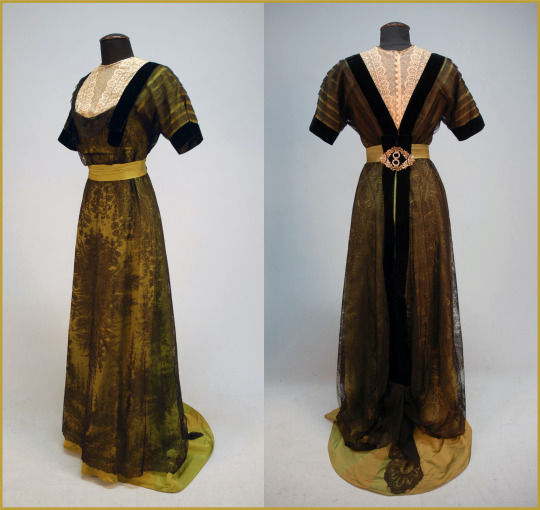
1912 Lady in Furs, Mrs. Charles A. Searles by Cilde Hassam (location ?). From tumblr.com/catherinedefrance 900X1090.
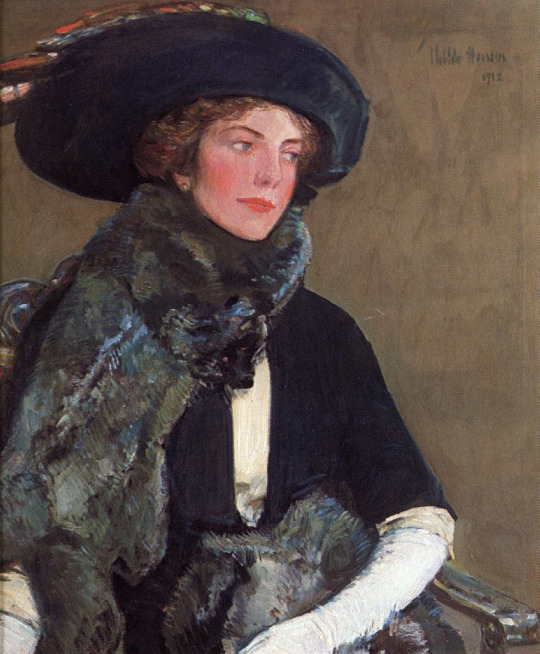
1912 Lady wearing a large hat sitting by Franz von Stuck (auctioned by Sotheby's). From their Web site 1753X1991.
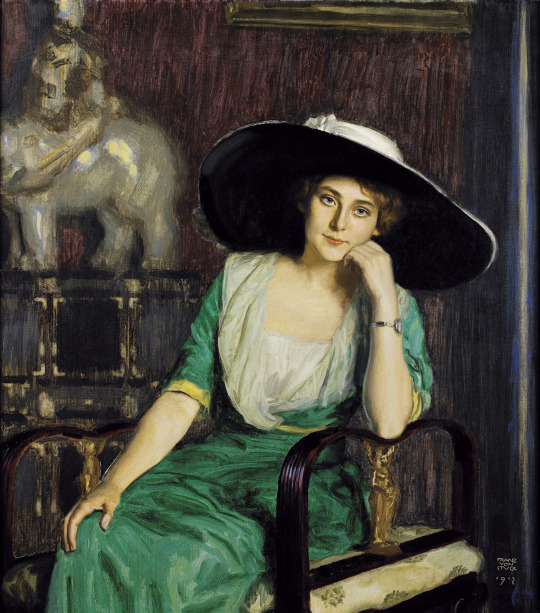
1912 Mrs J., by Józef Męcina-Krzesz (location ?). From godsandfoolishgrandeur.blogspot.com/2016/11/randomly-ix.html; shadows 60% and fixed spots w Pshop 750X975.
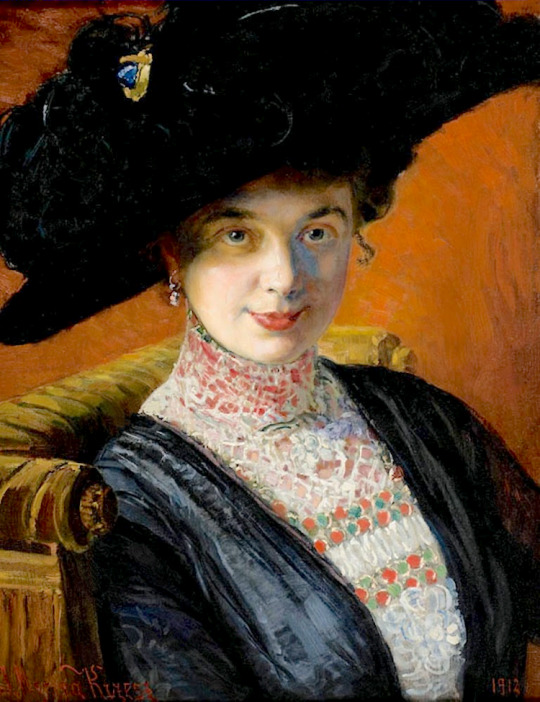
1912 Mrs. Ernest Guinness by Sir Francis Bernard Dicksee (auctioned by Christie's) From www.pinterest.com/nouvellegiselle/vintage-inspiration slightly cropped & fit to screen 924X1500.

1912 Mrs. John Lawrence by Edmund Tarbell (private collection). From cutlermiles.com/mrs-john-lawrence-edmund-tarbell/ 992X1280.
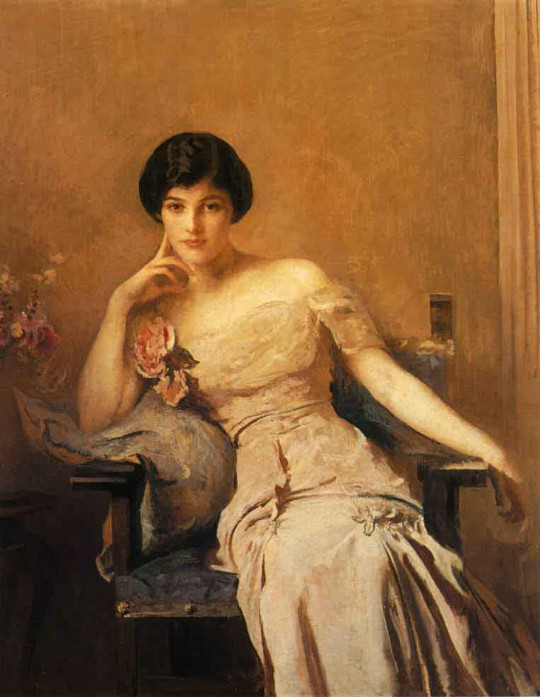
Left 1912 Princess Elena of Greece, nee Russia, in 1912, wearing the diamond and pearl tiara she later gave to her daughter as a wedding gift From pinterest.com/inara0798/aristocrats/ 602X960.
Center 1912 Princess Paley in a dinner dress with fancy headdress. From Sacheverelle's photostream on flickr 488X983.
Right 1912 Vizcondesa de Termens From laalacenadelasideas.blogspot.com/2012/12 1018X1316.


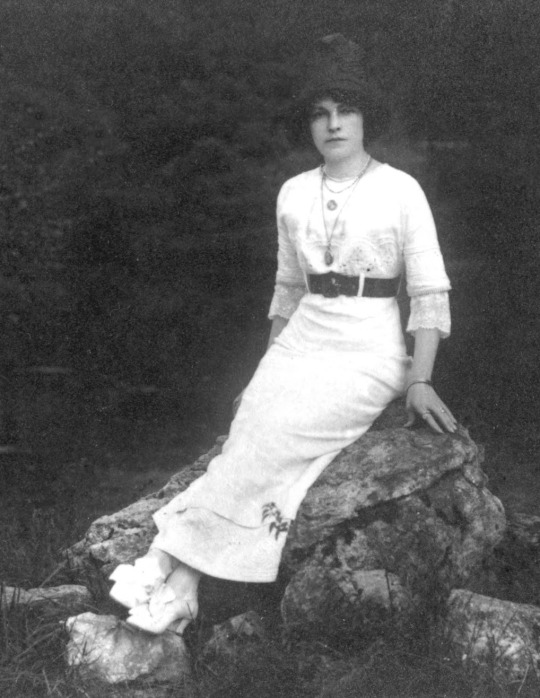
1912 Robe de Visite de Paquin (pl.5, La Gazette du Bon ton 1912-1913 n°2) by George Barbier. From edition-originale.com/en/prints-engravings-photographs/ 1682X2518.
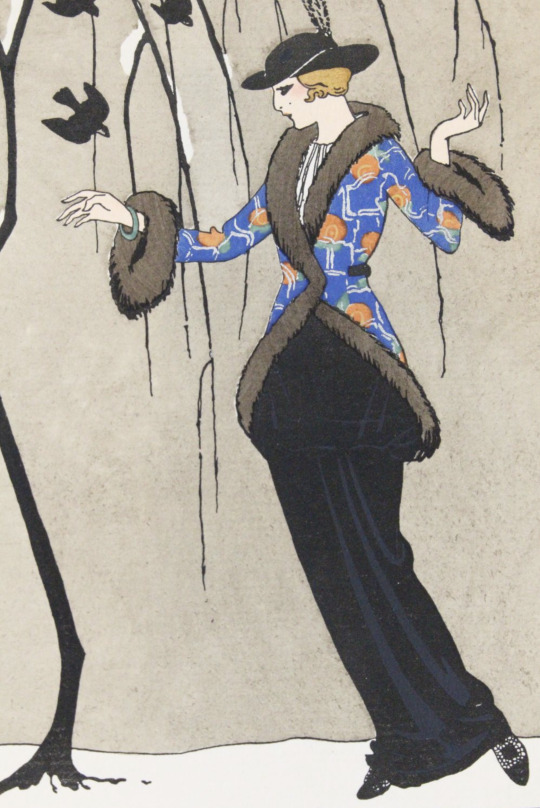
Left ca. 1912 Frau Prinzessin Rupprecht in Bayern, Marie Gabrielle in Bayern, by F. Grainer. From eBay fixed spots w Pshop 1017X1600.
Right ca. 1912-1913 Olga de Meyer wearing the famous Paul Poiret coat La Perse, photograph by Baron de Meyer. From facebook.com/144304418968266/photos/a.397639360301436/1143579645707400/?type=1&theater 1123X2048
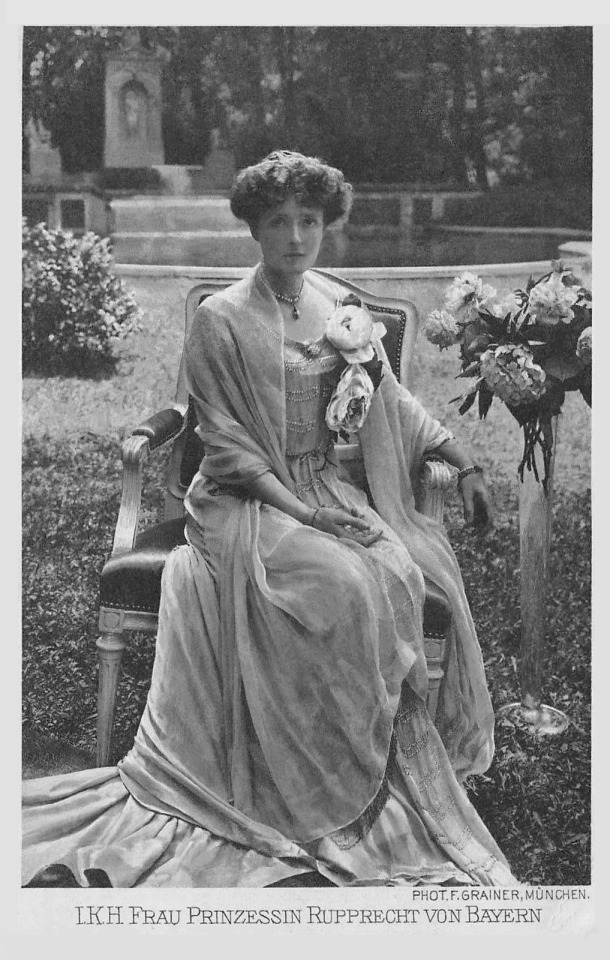

Left 1912 Winifred, Duchess of Portland by Philip Alexius de László (Portland College - Ravenshead, Nottinghamshire, UK). From books0977.tumblr.com/post/111045895147/the-duchess-of-portland-1912-philip-alexius-de 999X1280.
Right 1912 New Book by Walter Bonner Gash (location ?). From tumblr.com/larobeblanche/742427773413556224/the-new-book-c-1912? 876X1024.


Left 1912 Le Manteau bleu by Xavier Gosé (location ?). From tumblr.com/mote-historie/744587745354301440/painting-by-xavier-gos%C3%A9-le-manteau-bleu-1912?.
Center 1912 Fourrures Max (Max Furs) in the catalogue 'Fourrures Portraits Minatures' by George Barbier. From tumblr.com/mote-historie/732453186620866560/george-barbier-illustration-for-the-catalogue?source=share& 1939X2541.
Right 1912 Man and woman in evening dress by Coles Phillips (NYPL). From tumblr.com/sartorialadventure/747029584815489024?; fixed flaws & spots w Pshop 764X1000
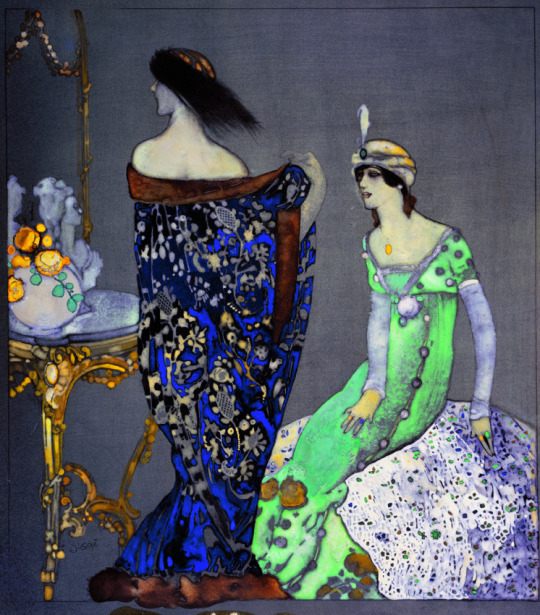
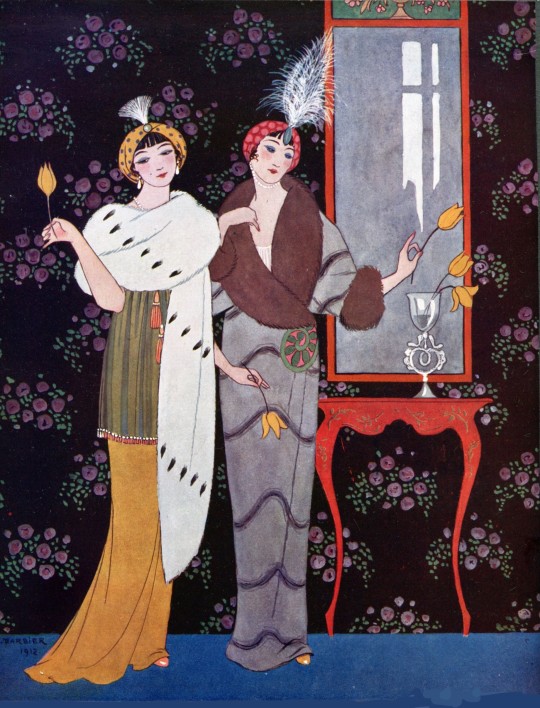
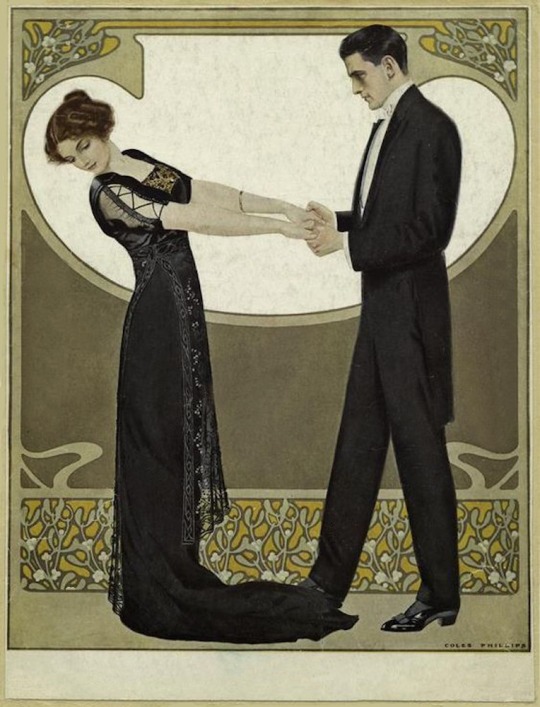
ca. 1912 a Femme chic, Supplément by A. Souchel (Rijksmuseum). From their Web site; fixed flaws & spots w Pshop 3229X5315.
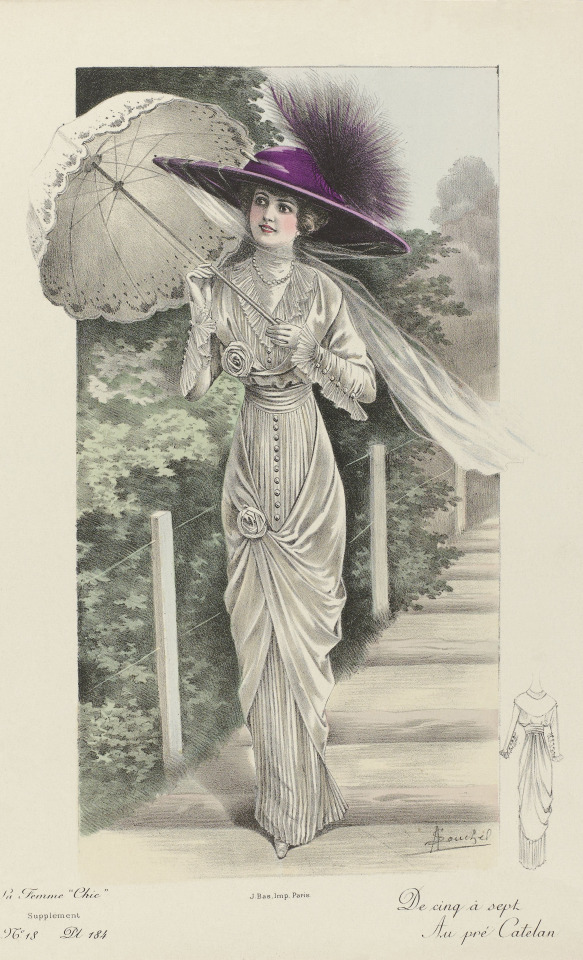
#1912 fashion#1910s fashion#Belle Époque fashion#Edwardian fashion#Lucile#Franz von Stuck#Mrs. J#Józef Męcina-Krzesz#Mrs. Ernest Guinness#Francis Bernard Dicksee#Mrs. John Lawrence#Edmund Tarbell#Princess Elena of Greece#Princess Paley#Worth#Vizcondesa de Termens#Jeanne Paquin#George Barbier#Marie Gabrielle in Bayern#F. Grainer#Olga de Meyer#Paul Poiret#Duchess of Portland Winifred#Philip Alexius de László#Xavier Gosé#Gash#Coles Phillips#A. Souchel#hobble skirt#parasol
36 notes
·
View notes
Photo

Romain de Tirtoff, better known as Erté, was born in St. Petersburg, Russia on November 23rd, 1892 and was raised amidst Russia's social elite. At the age of five he created an evening gown for his mother and managed to persuade the adults to craft it, they were astounded by the results. Romain, in 1912, left St. Petersburg for Paris at the age of nineteen with the aim of becoming an artist.After working with Paul " Le Magnifique" Poiret on several theatrical productions Romain, still under the pseudonym of Erte, began to work independently. He hand-crafted original costume and fashion designs for many of the era’s most renowned actresses, including Joan Crawford, Lillian Gish, Marion Davies, Anna Pavlova, Norma Shearer, and others. His masterpieces for the stage included extravagant production designs at venues such as New York’s Radio City Music Hall, the Casino de Paris, and the Paris Opera. In 1915 he began his long professional relationship with Harper's Bazaar and created 240 covers for the esteemed magazine. For 6 months in 1916, Erté simultaneously worked with Vogue as well. As a result of his highly publicized success, Erté would later be called the father of the ‘Art Deco’ movement.Today, some of his original designs are in the permanent collections of prestigious museums such as New York’s Metropolitan Museum of Art, Museum of Modern Art, the Smithsonian Institution and London’s Victoria & Albert Museum.
the #sighthound #Bulletin
5 notes
·
View notes
Text

'Goddess' gown by Paul Poiret, c. 1927
3 notes
·
View notes
Text




















National Pink Day
Some may say that pink is for girls and blue is for boys, but both the history of the color pink and how it is perceived today are much more complex and varied than that. Pink, which is celebrated today, is a pale color that falls somewhere between red and bluish-red, usually somewhere between red and magenta. Some shades, like the color salmon, are even orangish. The color was referenced in literature in ancient times, but its name dates to the seventeenth century when it was named for a flower that has the name.
The perception of pink in society has changed over the years. It has long been associated with femininity, and at times has been considered kitsch, erotic, sophisticated, or transgressive. It has also been associated with sweetness, tenderness, charm, sensitivity, childhood, and romance. When paired with white it has signified chastity and innocence, and when coupled with black it has conveyed eroticism and seduction.
During the Middle Ages, pink was used primarily in women’s fashion and in religious art, while during the Renaissance, it was used mainly for flesh color in paintings. Its rise in popularity in the West took place in the mid-eighteenth century. During that time, men and women wore faint, powdery pieces of pink clothing as a status symbol of luxury and class. Both male and female infants and children were dressed in the color—it was often more associated with males because it was seen as a lighter shade of red, which was a color viewed as masculine. Boys continued to wear pink well into the nineteenth century, including pink ribbons and decorations. Eighteenth-century paintings gave contrasting meanings of pink. Some depicted the color as being associated with childhood, innocence, or tenderness, while others showed it as a color of seduction.
In the mid-nineteenth century, pink shifted away from masculinity and was viewed as being delicate. One reason for this was that men started wearing darker colors, and women consequently began wearing and being associated with brighter, pastel colors. Eroticism began being associated with pink during this century as well because the color had a quality similar to nakedness. Lingerie began appearing in pink, and art and literature began referencing the color’s sexual quality, particularly the color’s relation to the female body.
The color had long been related to the higher classes of society, but during the twentieth century, there was a status shift that moved it from luxury to the working-class. This was on account of the proliferation of cheap dyes that allowed the creation of garish takes on the color. The hues became brighter and bolder, and the dyes didn’t easily fade. It was at this time pink entered what is viewed as the vulgar, being associated with prostitutes. But the connotation of luxury was not fully removed from the color. For example, during the first decades of the century, Paul Poiret, a French couturier, made exquisite dresses in shades of pink.
In the 1950s, the color became strongly associated with femininity, largely on account of Postwar branding and marketing. This is the era when pink became associated with girls and blue became associated with boys. A few happenings during the decade helped to push pink further into this direction. Mamie Eisenhower, the wife of President Dwight D. Eisenhower, wore a pink dress for her inaugural gown in 1953, and Audrey Hepburn’s 1957 film Funny Face featured many women wearing pink dresses. The color was often still seen as being frivolous at the time, which reflected a less-than-equal view of women that persisted during these pre-women’s liberation years.
When Jacqueline Kennedy and Marilyn Monroe began wearing it in the early 1960s, it once again was viewed as being luxurious. It was adopted by punk, pop, and hip-hop culture in the following decades. Pink triangles became a symbol of gay activism in the 1970s when they were claimed by gay activists and removed from their dreadful past when they were used by Nazis to identify homosexuals in concentration camps. In general, the color pink is now associated with the LGBTQ community.
In recent years, the color has also been used by women in the West as a symbol of feminist power and protest, where sexual, reproductive, and social rights are addressed. Pink pussyhats were worn at the 2017 Women’s March in Washington, D.C., on the day after the inauguration of President Donald Trump. Similarly, Code Pink is a women’s activist group that opposes war and globalization. The pink of the twenty-first century is both pretty and powerful, both feminine and feminist. Men in the West have even been embracing the color more in recent years. Still, the color is generally more accepted n the East. For example, in India, pink clothes, adornments, and turbans are commonly worn by both sexes.
The color is associated with Breast Cancer Awareness Month, during which Metastatic Breast Cancer Awareness Day takes place. A pink ribbon is the symbol of breast cancer awareness. Other holidays such as Pink Cadillac Day and Pink Flamingo Day—which happens to take place today—celebrate with the color.
Pink can be seen almost everywhere you look. It is used in idioms and phrases such as “give a pink slip” and “tickled pink”; flowers bloom bearing its color; many foods and drinks sparkle with it; clothes and makeup are shaded with its hue; and even the rising and setting of the sun greet us and wave to us with shades of pink. No matter where pink is found, we celebrate it today!
How to Observe
Here are some ideas on how to spend the day:
Wear some pink clothes, a pink hat, or some pink shoes.
Buy something that is pink.
Wear pink lipstick or blush, or dye your hair pink.
Eat some pink colored food, such as watermelon, peeps, rhubarb, salmon, shrimp, grapefruit, ham, or cotton candy.
Drink some pink colored beverages such as a strawberry shake or pink lemonade. Some cocktail options include the Pink Lady and the Pink Squirrel.
Listen to a song or watch a film with “pink” in the title.
Celebrate Pink Flamingo Day, which also takes place today.
Have a party and incorporate as many pink things as possible, including pink decorations, food, and clothes.
Plant, pick, or buy some pink flowers, such as roses, hibiscuses, tulips, peonies, or hyacinths.
Look for a pinkish light from the sun early in the morning or in the evening before it goes down.
Read a book about the color pink, such as Pink: The History of a Punk, Pretty, Powerful Color by Valerie Steele.
Source
#National Pink Day#NationalPinkDay#23 June#Spain#Mellanfjärden#Hudiksvall#Bohus Fortress#Gettysburg National Military Park#Pennsylvania#Sweden#travel#nature#flora#vacation#I don't wear pink often#too girly for me#original photography#tourist attraction#landmark#cityscape#architecture#landscape#USA#Canada#Portugal#Atlanta#Indianapolis#Houston#Four Corners Monument#Monument Valley
1 note
·
View note
Text
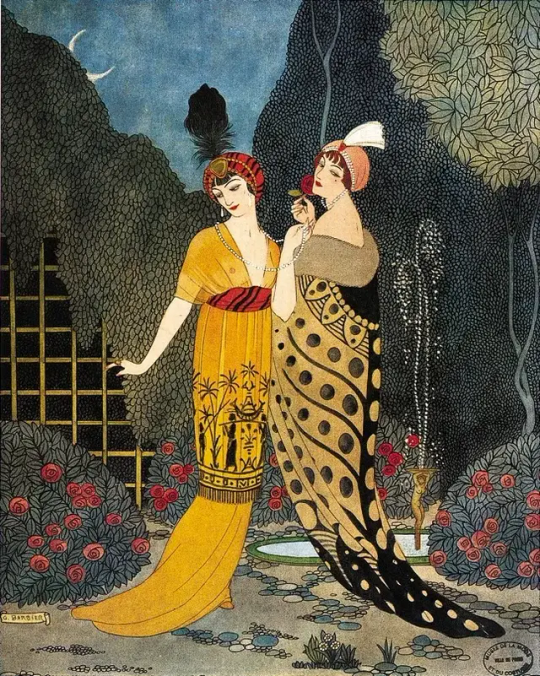
George Barbier, Paul Poiret gowns, Les Modes, 1912.
Colour illustration by George Barbier from Les Modes showing two young women wearing dramatic evening outfits influenced by the current interest in orientalism, one is an empire line gown in gold draped fabric featuring a printed Egyptian scene, the other is a loose fitting wrap style mantle with a black, grey and white geometric design and fur collar, both women wear turban style hats with feathers, Paris, France,1912. (x)
#george barbier#illustration#paul poiret#1912#les modes#les modes paris#orientalism#gowns#edwardian#painting#art#vintage#egyptian#aigrette#poiret#barbier#1910s fashion#chic#parisian chic#poiret design#poiret gowns#paul poiret design#fashion#fashion illustration#1912 illustrations#french art#french fashion#paris#paris fashion
83 notes
·
View notes
Text
The 1920s - part 1
The Roaring Twenties
1920s liberation from the corset

During and after WW1 woman’s social role changed. Representation of the ideal for fairer sex had radically changed.
The Shape
At the beginning of the 1920s the waist was still apparent however no where near as cinched as the years before but the length of skirts had decreased and clothes were less shaped, in these images we can see the beginning of the shape we associate with 1920s.


The 1920s was a time for glamour, dresses were covered in beads and revealed more flesh than ever before. A huge contrast to 10 years earlier when women dressed head to toe in gowns with corsets.
If you were in the right social class it was a time of partying and living life to the full. Society girls could be seen drinking, smoking and riding around in cars from party to party.
La Garconne
La Garconne translates "the bachelor girl" or "the flapper,"

Cover of La Garconne (1922) by Victor Margueritte.
This was the novel from which the fashionable look of the 1920s is believed to have gotten its name. The illustration shows the books scandalous heroine, Monique Lerbier, who cut her hair short wore men’s shirts/ jackets and ties, and gave birth outside wedlock.
In reality La Garconne at the time was more of a derogatory term for women of loose morals and newly liberated woman, freed from the ‘ Gibson girl’ corsetry and S-bend silhouettes of the Edwardian era The constraints on her lifestyle that such clothing, inflicted on her.
The simplicity that characterized La Garconne look was showcased mainly in cut rather than fabric. The straight-cut chemise dress was to become the dominant line for day and evening wear in this period.

These young women from 1926 are seen to be wearing cloche hats and decorated drop waisted dresses with matching jackets. The long string of pearls/beads was a must have for any sophisticated attire during this period.
By 1924 trousers were becoming more popular for women and were worn with the new androgynous haircut. Paul Poiret’s washable satin pyjamas were idolised and exstreamly popular, if you could afford it.

Josephine Baker
Josephine Baker was a dancer and singer who became wildly popular in France during the 1920s. At the time she was europe's most popular and highest-paid performer. She worked for the French Resistance during WWII, and during the 1950s and '60s she devoted herself to fighting segregation and racism in the United States.

Many celebrities have been inspired by Josephine Baker's style such as Diana Ross and Beyoncé.

youtube
Here is one of Josephine Baker's many shows where she is dancing the original Charleston.
The Great Gatsby
The Great Gatsby is a 1925 novel written by American author F.Scott Fitzgerald. It follows a cast of characters living in the fictional town of West Egg on prosperous Long Island in the summer of 1922. The story mainly concerns the young and mysterious millionaire Jay Gatsby and his obsession for the beautiful Daisy Buchanan. The Great Gatsby explores themes of decadence, idealism, resistance to change, social upheaval, and excess, creating a portrait of the Roaring Twenties.

1 note
·
View note
Photo

Marchesa Luisa Casati in a fountain dress made of wires and lights by couturier Paul Poiret, at the Beaumont Ball held by the Count Etienne de Beaumont in Paris, 1924.
The Beaumont Ball in Paris 1924 (an event with a guest list so selective that Gabrielle Coco Chanel was excluded for being too ‘trade’), was a homage to Pablo Picasso and the Cubists. The dress made entirely from wires and lights, it was too wide for the entrance to Beaumont’s ballroom: the artist Christian Bérard, who witnessed Marchesa Luisa Casati attempting to squeeze through the doorway, reported that she collapsed like a “smashed zeppelin”. (x)
De Beaumont’s fêtes reached an apex in 1924 with the ballet series Soirées de Paris, which took place at the Théâtre de la Cigale in Montmartre from May 17 to June 30, 1924. An homage to the review of the same name by Guillaume Apollinaire, the series included the scandalous ballet Mercure, which featured music composed by Erik Satie, sets and costumes designed by Pablo Picasso, and choreography devised by Léonide Massine. (x)
#marchesa luisa casati#paul poiret#1924#paul poiret gown#poiret#poiret fashion#Beaumont Ball#count Étienne de beaumont#smashed zeppelin#fountain dress#fêtes#1920s paris#paris ball#gabrielle coco chanel#mercure#luisa casati#la casti#la marchesa#marchesa casati#marchesa casati stampa#marquise casati#Marquise Casati Stampa di Soncino#marquise casati stampa#La Marquise de Casati#italian aristocrat#italian socialites#christian bérard#pablo picasso#cubists#soirées de paris
400 notes
·
View notes
Photo




Poiret evening dress, 1928
From Kerry Taylor Auctions
911 notes
·
View notes
Text
Gay Pirate Dressing Gown Project
In a moment of weakness I indulged in the gay pirate velvet fabric and the hottest of hot pink silk.
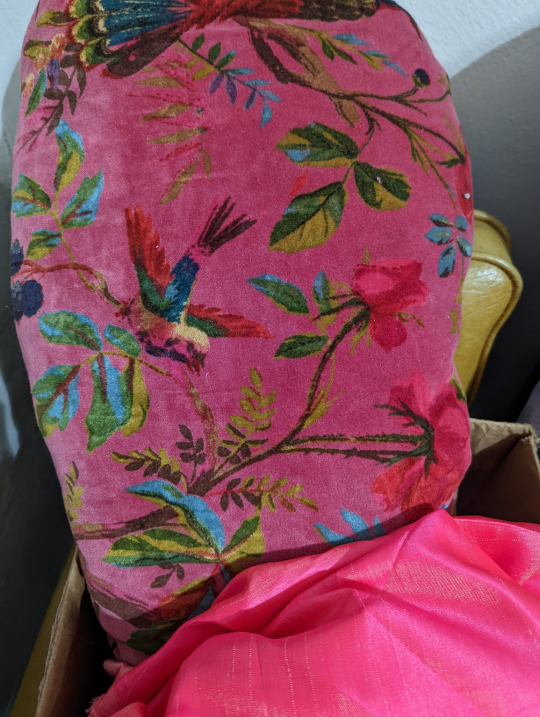
I've got it rolled up protectively and have literally been sleeping with it next to my pillow. Mostly because the cat is a little too interested in it and I'm not leaving it vulnerable to her late night shenanigans.
A couple of years ago in a fit of boredom I sewed myself a drape-y, flow-y, extremely-loosely-kimono-inspired robe out of an old duvet cover. I didn't use a pattern as I was a) making it up as I went and b) trying to use the fabric as efficiently as possible. I had to leave it behind when I moved and, unexpectedly, missed wafting around in a queen duvet amount of fabric.
So, while I enjoy the costumes on the show I'm going in a stylistically different direction. My pinterest board for this project is mainly stuff like this:


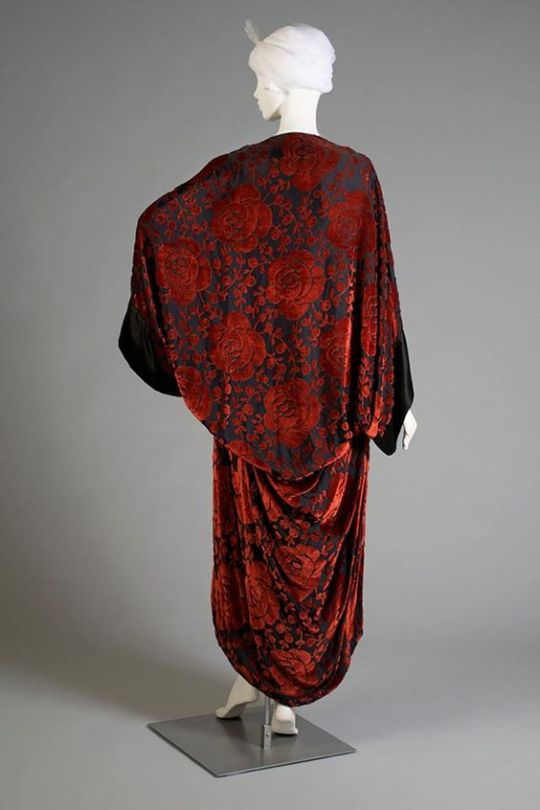
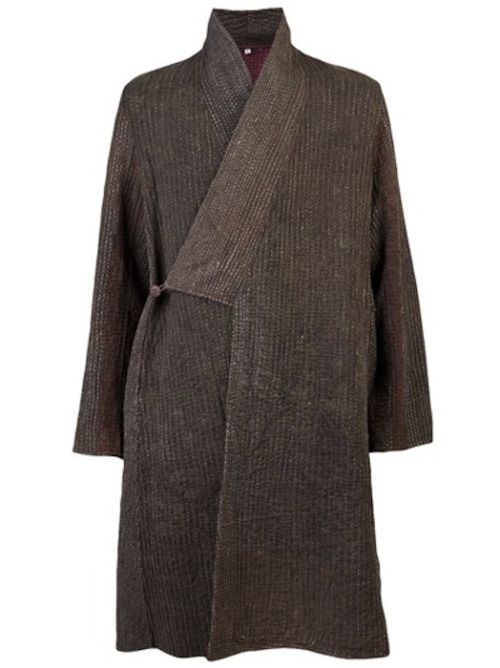
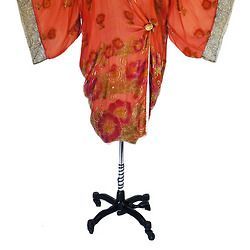
Thanks for my hunt to figure out what those horizontal drapes on the back could possibly be called (cocoon!) I have discovered the designer Poiret. He was definitely appropriating styles from the middle east and east asia, but also developed quintessentially 1920s garments. At least according to this beautiful art book I checked out from the library:
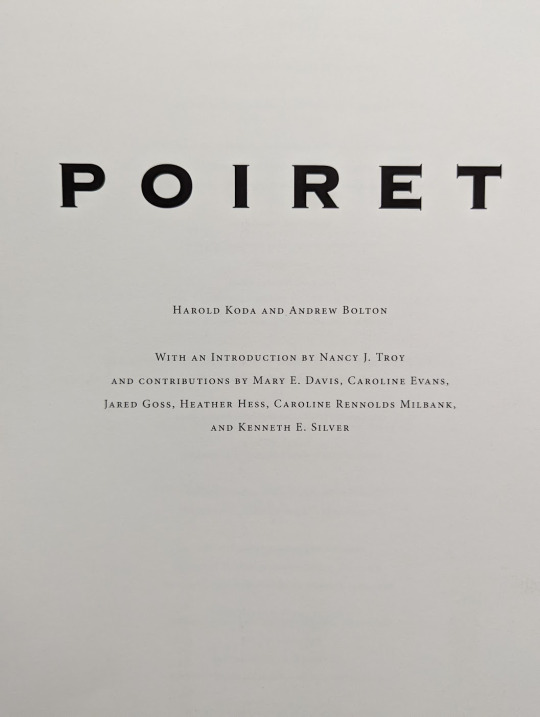
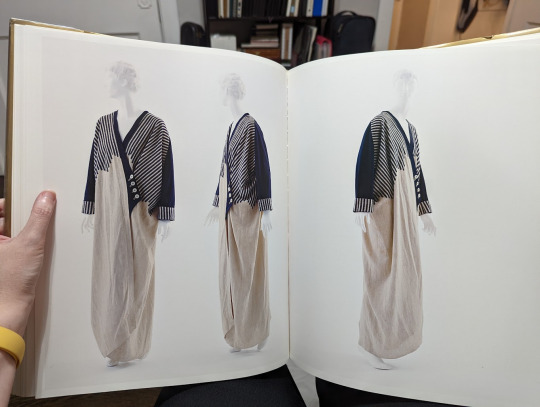

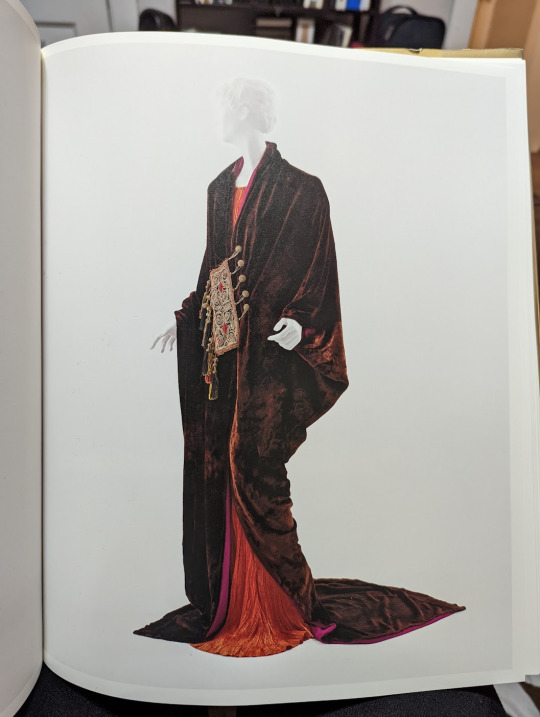
It turns out a lot of this is cleverly draped single lengths of velvet - which won't work at all with the patterned fabric unless I want birds who don't give a shit about gravity. Which I don't.
But I do want this cocoon shape. Very badly. And a fainting couch.
#gay pirate#ofmd#dressing gown#research#paul poiret#cocoon coat#sewing project#wip#am i taking this too far
26 notes
·
View notes
Text
Fashion Showdown: Silver (Match 5)


22 notes
·
View notes